Themed collection Polymer Chemistry 15th anniversary regional spotlight collection: Europe

Dynamic covalent chemistry in polymer networks: a mechanistic perspective
A selection of dynamic chemistries is highlighted, with a focus on the reaction mechanisms of molecular network rearrangements, and on how mechanistic profiles can be related to the mechanical and physicochemical properties of polymer materials.
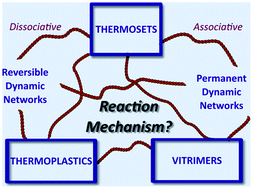
Polym. Chem., 2019,10, 6091-6108
https://doi.org/10.1039/C9PY01260E
How to manipulate the upper critical solution temperature (UCST)?
In this mini-review, we discuss multi-stimuli-responsive polymers, which exhibit upper critical solution temperature (UCST) behavior mainly in aqueous solutions, and focus on examples where counter ions, electricity, light, or pH influence the thermoresponsiveness of these polymers.
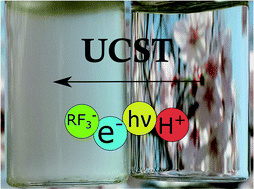
Polym. Chem., 2017,8, 220-232
https://doi.org/10.1039/C6PY01612J
Polymers with redox properties: materials for batteries, biosensors and more
Innovative polymers with redox properties are highlighted in this manuscript together with their actual applications in the energy, materials science and biomedical fields.
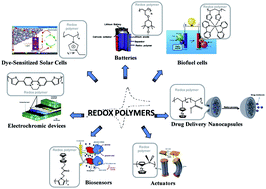
Polym. Chem., 2013,4, 2206-2214
https://doi.org/10.1039/C3PY21118E
Thermoresponsive block copolymers of increasing architecture complexity: a review on structure–property relationships
The position of the monomers within the polymer chain and the 3D structure of the polymer affect the thermoresponsive properties.
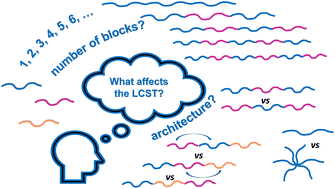
Polym. Chem., 2023,14, 223-247
https://doi.org/10.1039/D2PY01097F
Recent advances in self-immolative linkers and their applications in polymeric reporting systems
In this review we describe advances in the design of self-immolative linkers and their application in polymeric reporting systems.

Polym. Chem., 2022,13, 3188-3269
https://doi.org/10.1039/D2PY00414C
Hydrogel scaffolds for tissue engineering: the importance of polymer choice
We explore the design and synthesis of hydrogel scaffolds for tissue engineering from the perspective of the underlying polymer chemistry. The key polymers, properties and architectures used, and their effect on tissue growth are discussed.

Polym. Chem., 2020,11, 184-219
https://doi.org/10.1039/C9PY01021A
Organocatalysis for depolymerisation
Chemical recycling of plastics offers a green method to deal with plastic waste. In this review, we highlight the recent advances made by applying organocatalysts to chemically degrade polymers as a promising tool to reach a circular plastic economy.
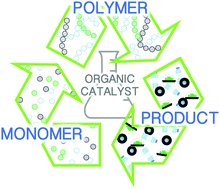
Polym. Chem., 2019,10, 172-186
https://doi.org/10.1039/C8PY01284A
Catalytic metal-based systems for controlled statistical copolymerisation of lactide with a lactone
A comprehensive survey of the recent developments of metal-based catalysts for the ROcoP of lactide with another lactone is presented.

Polym. Chem., 2018,9, 2517-2531
https://doi.org/10.1039/C8PY00310F
Toughening of photo-curable polymer networks: a review
This review surveys relevant scientific papers and patents on the development of crosslinked epoxies and also photo-curable polymers based on multifunctional acrylates with improved toughness.
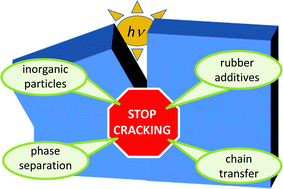
Polym. Chem., 2016,7, 257-286
https://doi.org/10.1039/C5PY01631B
Lignocellulosic biomass: a sustainable platform for the production of bio-based chemicals and polymers
The ongoing research activities in the field of lignocellulosic biomass for production of value-added chemicals and polymers that can be utilized to replace petroleum-based materials are reviewed.
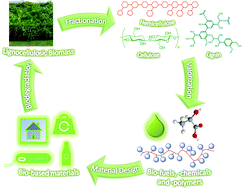
Polym. Chem., 2015,6, 4497-4559
https://doi.org/10.1039/C5PY00263J
Multi-stimuli responsive polymers – the all-in-one talents
The integration of several responsive moieties within one polymer yields smart polymers exhibiting a multifaceted responsive behaviour.

Polym. Chem., 2014,5, 25-36
https://doi.org/10.1039/C3PY00880K
Synthesis of biodegradable polymers from renewable resources
The present review is concerned with catalytic reactions that can help to transform carbohydrates and vegetable oils into biodegradable materials.
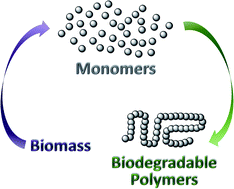
Polym. Chem., 2012,3, 836-851
https://doi.org/10.1039/C2PY00452F
Overcoming the PEG-addiction: well-defined alternatives to PEG, from structure–property relationships to better defined therapeutics
In this review, recent developments in controlled polymerisation techniques which can be used to improve and tailor the properties of polymer therapeutics are highlighted. In particular, alternatives to PEG based systems are emphasised.
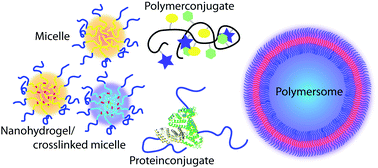
Polym. Chem., 2011,2, 1900-1918
https://doi.org/10.1039/C0PY00406E
End group removal and modification of RAFT polymers
This paper highlights the well-established routes and recent advances in the end group modification of polymers synthesised by reversible addition–fragmentation chain transfer (RAFT) polymerisation.

Polym. Chem., 2010,1, 149-157
https://doi.org/10.1039/B9PY00340A
Light-accelerated depolymerization catalyzed by Eosin Y
Eosin Y is used as a photocatalyst for the acceleration of the depolymerization of polymethacrylates.
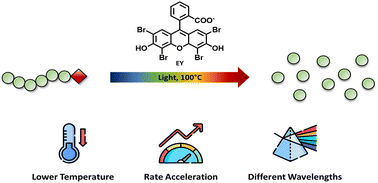
Polym. Chem., 2023,14, 253-258
https://doi.org/10.1039/D2PY01383E
Digital light processing 3D printing with thiol–acrylate vitrimers
The customized fabrication of soft active devices with self-healing function is demonstrated by 3D printing with vitrimeric thiol–acrylate photopolymers.

Polym. Chem., 2021,12, 639-644
https://doi.org/10.1039/D0PY01520B
Vanillin-based dual dynamic epoxy building block: a promising accelerator for disulfide vitrimers
A dual-dynamic bio-based epoxy building block (DDBB) with both imine and disulfide bonds synthesized from cystamine and vanillin showed accelerated dynamic exchanges in disulfide vitrimer formulations.
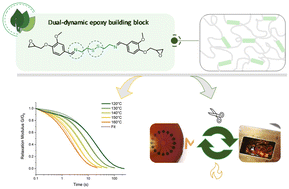
Polym. Chem., 2024,15, 1347-1357
https://doi.org/10.1039/D4PY00038B
Polycondensations and cyclization of poly(L-lactide) ethyl esters in the solid state
The usefulness of seven different tin catalysts, bismuth subsalicylate and titan tetra(ethoxide) for the polycondensation of ethyl L-lactate (ELA) was examined at 150 °C for 6 d.

Polym. Chem., 2024,15, 71-82
https://doi.org/10.1039/D3PY01232H
Autonomous polymer synthesis delivered by multi-objective closed-loop optimisation
An artificially intelligent flow-reactor platform equipped with online NMR and GPC enables autonomous polymerisation optimisation utilising a machine learning algorithm to map the trade-off between monomer conversion and dispersity.

Polym. Chem., 2022,13, 1576-1585
https://doi.org/10.1039/D2PY00040G
The effect of polarity on the molecular exchange dynamics in imine-based covalent adaptable networks
Polarity-induced effects in dynamic covalent polyimine CANs were studied, revealing a three-step stress relaxation process.
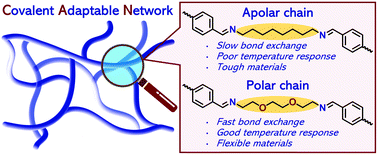
Polym. Chem., 2021,12, 1635-1642
https://doi.org/10.1039/D0PY01555E
A cardanol-based polybenzoxazine vitrimer: recycling, reshaping and reversible adhesion
This paper reports the development of the first vitrimer based on polybenzoxazines containing disulfide bonds and cardanol.
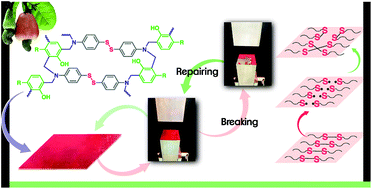
Polym. Chem., 2020,11, 7026-7034
https://doi.org/10.1039/D0PY01239D
Ferromagnetic iron oxide–cellulose nanocomposites prepared by ultrasonication
Uniformly dispersed iron oxide–cellulose ferromagnetic nanocomposites were successfully obtained by ultrasonication, as a clean and energy-saving method.

Polym. Chem., 2018,9, 860-868
https://doi.org/10.1039/C7PY01587A
Long-term stability and reusability of molecularly imprinted polymers
The effect of crosslinker, functional monomer and extraction on the long-term performance and degradation of molecularly imprinted polymers was investigated through adsorption studies, NMR, SEM, TGA and BET.
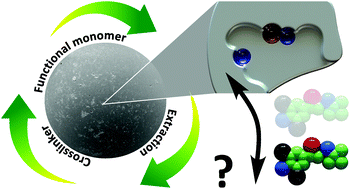
Polym. Chem., 2017,8, 666-673
https://doi.org/10.1039/C6PY01853J
Coordination and catalysis of Zn2+ in epoxy-based vitrimers
Network-coordinated Zn2+ ions activate carbonyls, promote alkoxides and hold reactants close to each other for transesterification.

Polym. Chem., 2016,7, 4486-4493
https://doi.org/10.1039/C6PY00752J
Chemically crosslinked yet reprocessable epoxidized natural rubber via thermo-activated disulfide rearrangements
Disulfide crosslinks introduced into an ENR matrix enable the thermo-activated reprocessing of the chemically crosslinked rubber, studied in terms of stress relaxation and adhesion experiments.
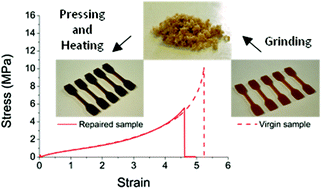
Polym. Chem., 2015,6, 4271-4278
https://doi.org/10.1039/C5PY00459D
Photo-induced copper-mediated polymerization of methyl acrylate in continuous flow reactors
Copper-mediated radical polymerization of acrylates was carried out in micro- and milliscale UV continuous flow reactors in the absence of conventional photoinitiators.
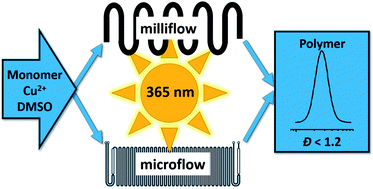
Polym. Chem., 2014,5, 3053-3060
https://doi.org/10.1039/C3PY01762A
Self-healing systems based on disulfide –thiol exchange reactions
New thermoset systems based on disulfide bonds were synthesized with self-healing capabilities.
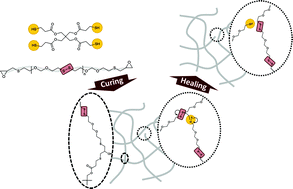
Polym. Chem., 2013,4, 4955-4965
https://doi.org/10.1039/C3PY00087G
Functional conjugated microporous polymers : from 1,3,5-benzene to 1,3,5-triazine
Conjugated microporous polymers (CMPs) based on electron-withdrawing 1,3,5-triazine nodes show surface areas of up to 995 m2 g¬1, enhanced carbon dioxide uptakes compared to non-triazine CMPs, and optical band gaps that can be engineered by copolymerization.
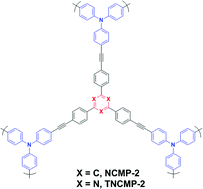
Polym. Chem., 2012,3, 928-934
https://doi.org/10.1039/C2PY00585A
Efficient dual radical/cationic photoinitiator under visible light: a new concept
A new photoinitiating system able to generate both a radical and a cation as an initiating species is presented.
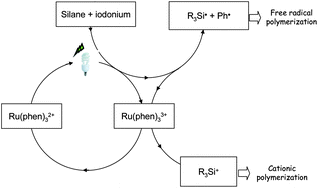
Polym. Chem., 2011,2, 1986-1991
https://doi.org/10.1039/C1PY00140J
How controlled and versatile is N-carboxy anhydride (NCA ) polymerization at 0 °C? Effect of temperature on homo-, block- and graft (co)polymerization
The polymerization of N-carboxyanhydride (NCA) at low temperatures is controlled and allows the synthesis of a variety of well-defined polypetides.

Polym. Chem., 2010,1, 514-524
https://doi.org/10.1039/B9PY00337A
About this collection
To celebrate the 15th anniversary of Polymer Chemistry we have curated a collection of some of our most popular articles with corresponding authors based in Europe. We would like to take this opportunity to thank all our contributors from Europe for continuing to provide high quality research to Polymer Chemistry and we look forward to seeing what developments the next 15 years will bring!
This five-part series will be showcasing some of our very best authors from across 5 regions: